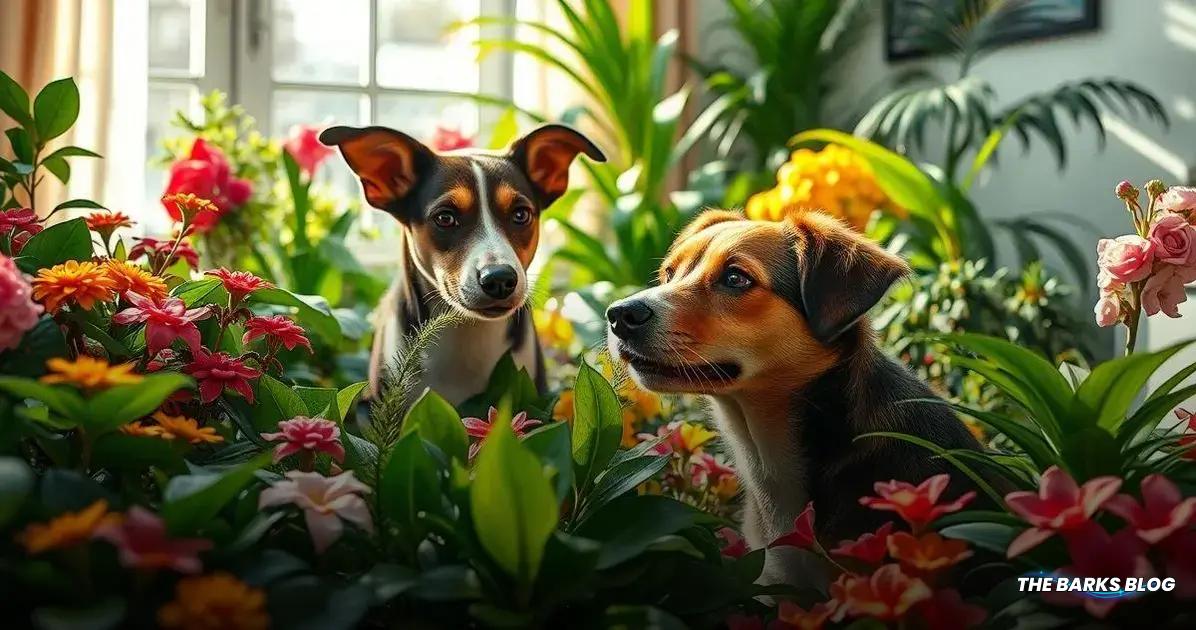It’s essential for dog owners to know which plants are toxic to their pets, as common plants like rhododendrons, lilies of the valley, and azaleas can cause serious health problems if ingested. To ensure a safe environment for dogs, research plants before introducing them to your home or garden, and consult resources like the ASPCA for a complete list of toxic plants.
Is it possible to be both a pet parent and a plant parent? We’ve all met a curious dog who likes to explore the world with their mouth – but aren’t some plants toxic to dogs? Well, yes!
So, if you’re thinking about adorning your apartment with florals or greenery, or you’re fixing up your yard with some impressive flowers and planters, it’s probably worth knowing which plants are poisonous to dogs…

Poisonous Plants For Dogs
The Poisonous Plants For Dogs list details common household or garden plants that may pose a threat to your dog’s health and wellbeing. It’s crucial to be aware of these plants to keep your furry friends safe.
- Rhododendrons: These beautiful shrubs can cause vomiting, diarrhea, and even more severe symptoms if ingested.
- Hydrangeas: While stunning, hydrangeas can lead to gastrointestinal upset and lethargy in dogs.
- Lily of the Valley: This plant contains compounds that can affect the heart, leading to serious health issues.
- Peonies: Though lovely, peonies can cause vomiting and diarrhea if consumed.
- Primroses: These flowers can be harmful, causing digestive upset in dogs.
- Poinsettias: Often associated with the holidays, they can cause mild irritation and discomfort if ingested.
- Crocuses: While spring brings their beauty, crocuses can cause vomiting and diarrhea.
- Tulips: The bulbs are particularly toxic, leading to severe gastrointestinal issues if eaten.
- Amaryllis: Known for their striking blooms, they can lead to vomiting and diarrhea.
- Iris: This plant can cause vomiting and diarrhea and should be kept away from curious pups.
- Lavender: While often used for its calming properties, too much lavender can cause gastrointestinal issues.
- Holly: The berries can be toxic and lead to vomiting and diarrhea.
- Azaleas: Even small amounts can cause serious health issues, including vomiting and lethargy.
- Carnations: These flowers can cause mild gastrointestinal upset if ingested.
- Chives: Part of the onion family, they can lead to gastrointestinal upset and even anemia.
- Eucalyptus: Known for its aromatic properties, ingestion can cause vomiting and diarrhea.
- Gladiola: These can cause gastrointestinal upset if consumed by dogs.
- St. John’s Wort: This plant can lead to photosensitivity and gastrointestinal issues.
- Periwinkles: They can cause vomiting and diarrhea if ingested.
- Sweet Peas: These can lead to serious health issues if consumed by dogs.
- Parsley: While safe in small amounts, too much can be harmful.
- Wisteria: This beautiful climber can cause severe gastrointestinal issues.
- Figs: The leaves and fruit can cause gastrointestinal upset.
- Mint: While often used for flavoring, too much can cause digestive issues.
- Rhubarb: The leaves are toxic and can lead to severe health problems.
- Yew: This plant is highly toxic and can be fatal if ingested.
Please note that this list is not exhaustive and it only includes some of the most common plants you may find in your neighborhood or home. For a full list of plants known to be toxic to dogs, check out the ASPCA’s list here.
Conclusion
As a pet parent, it’s essential to be aware of the plants that can pose a risk to your dog’s health.
By avoiding toxic plants like rhododendrons, lilies of the valley, and azaleas, you can create a safer environment for your furry friend.
Always do your research before bringing new plants into your home or garden, and consult reliable sources like the ASPCA for comprehensive information.
Remember, keeping your dog safe is as important as nurturing your green thumb!
FAQ – Frequently Asked Questions about Toxic Plants for Dogs
What are some common plants that are toxic to dogs?
Common toxic plants for dogs include rhododendrons, lilies of the valley, azaleas, and tulips.
What should I do if my dog eats a toxic plant?
If you suspect your dog has ingested a toxic plant, contact your veterinarian or the ASPCA Animal Poison Control Center immediately.
How can I create a dog-friendly garden?
To create a dog-friendly garden, choose non-toxic plants such as sunflowers, basil, and marigolds, and avoid known toxic plants.
Are all parts of toxic plants harmful to dogs?
Yes, many toxic plants have harmful parts, such as bulbs, leaves, and berries, which can pose different levels of risk.
How can I identify if a plant is safe for my dog?
Research the plant species before bringing it home, or consult resources like the ASPCA’s list of toxic and non-toxic plants.
Can I have indoor plants if I have a dog?
Yes, you can have indoor plants, but ensure they are non-toxic to dogs to prevent any health risks.




